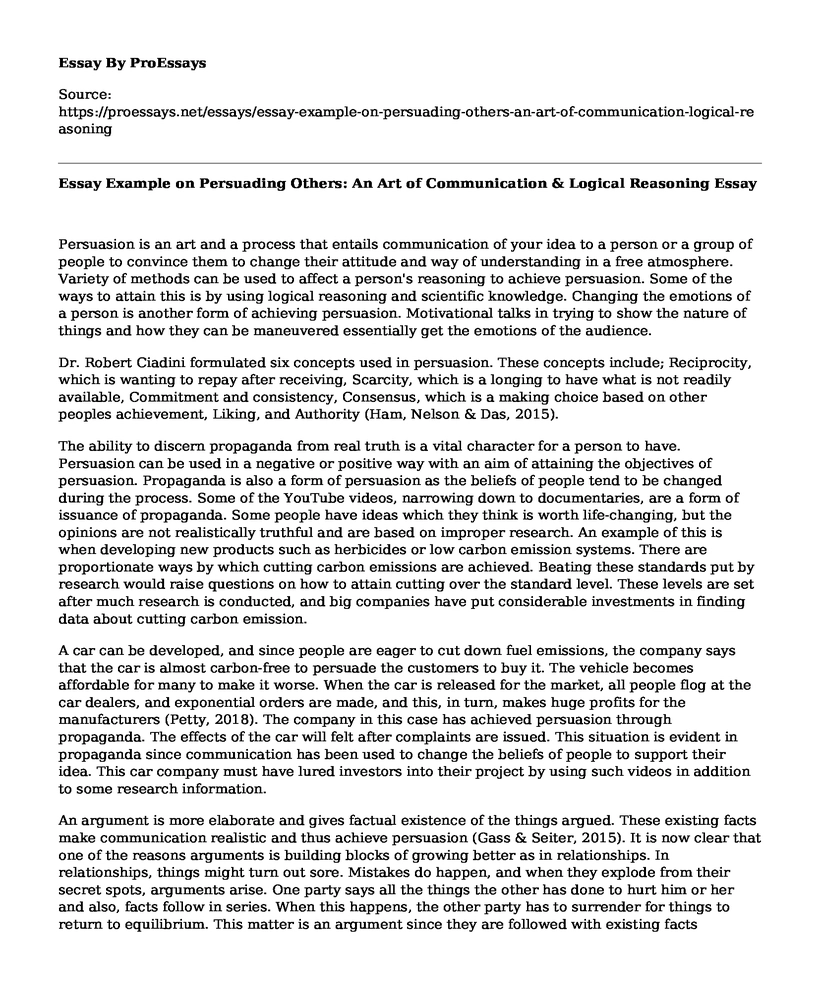Persuasion is an art and a process that entails communication of your idea to a person or a group of people to convince them to change their attitude and way of understanding in a free atmosphere. Variety of methods can be used to affect a person's reasoning to achieve persuasion. Some of the ways to attain this is by using logical reasoning and scientific knowledge. Changing the emotions of a person is another form of achieving persuasion. Motivational talks in trying to show the nature of things and how they can be maneuvered essentially get the emotions of the audience.
Dr. Robert Ciadini formulated six concepts used in persuasion. These concepts include; Reciprocity, which is wanting to repay after receiving, Scarcity, which is a longing to have what is not readily available, Commitment and consistency, Consensus, which is a making choice based on other peoples achievement, Liking, and Authority (Ham, Nelson & Das, 2015).
The ability to discern propaganda from real truth is a vital character for a person to have. Persuasion can be used in a negative or positive way with an aim of attaining the objectives of persuasion. Propaganda is also a form of persuasion as the beliefs of people tend to be changed during the process. Some of the YouTube videos, narrowing down to documentaries, are a form of issuance of propaganda. Some people have ideas which they think is worth life-changing, but the opinions are not realistically truthful and are based on improper research. An example of this is when developing new products such as herbicides or low carbon emission systems. There are proportionate ways by which cutting carbon emissions are achieved. Beating these standards put by research would raise questions on how to attain cutting over the standard level. These levels are set after much research is conducted, and big companies have put considerable investments in finding data about cutting carbon emission.
A car can be developed, and since people are eager to cut down fuel emissions, the company says that the car is almost carbon-free to persuade the customers to buy it. The vehicle becomes affordable for many to make it worse. When the car is released for the market, all people flog at the car dealers, and exponential orders are made, and this, in turn, makes huge profits for the manufacturers (Petty, 2018). The company in this case has achieved persuasion through propaganda. The effects of the car will felt after complaints are issued. This situation is evident in propaganda since communication has been used to change the beliefs of people to support their idea. This car company must have lured investors into their project by using such videos in addition to some research information.
An argument is more elaborate and gives factual existence of the things argued. These existing facts make communication realistic and thus achieve persuasion (Gass & Seiter, 2015). It is now clear that one of the reasons arguments is building blocks of growing better as in relationships. In relationships, things might turn out sore. Mistakes do happen, and when they explode from their secret spots, arguments arise. One party says all the things the other has done to hurt him or her and also, facts follow in series. When this happens, the other party has to surrender for things to return to equilibrium. This matter is an argument since they are followed with existing facts engraved in emotional outbursts to prove one's action.
Using the definition of persuasion by Mr. Jernigan, it is possible to say that campaigning for votes is an example of persuasion. He says persuasion is changing people's minds to make them so something (McLean, S. (2012)). In campaigning, the politicians try to show their competence for people to vote for them. There is a reward for persuasion. Politicians tend to be witty for achieving and gathering tones of votes. This scenario fits persuasion rather than argument or propaganda since some of the politicians' work are evident. Also, it is not a two-way activity (politicians talk to the audience but never does the audience communicate to the politician).
References
Gass, R. H., & Seiter, J. S. (2015). Persuasion: Social Influence and Compliance Gaining.Routledge.
Ham, C. D., Nelson, M. R., & Das, S. (2015). How to measure persuasion knowledge.International Journal of Advertising, 34(1), 17-53. Retrieved from: https://www.tandfonline.com/doi/abs/10.1080/02650487.2014.994730
Petty, R. E. (2018). Attitudes and persuasion: Classic and contemporary approaches. Routledge.s
Cite this page
Essay Example on Persuading Others: An Art of Communication & Logical Reasoning. (2023, Feb 11). Retrieved from https://proessays.net/essays/essay-example-on-persuading-others-an-art-of-communication-logical-reasoning
If you are the original author of this essay and no longer wish to have it published on the ProEssays website, please click below to request its removal:
- Gender Roles in Society Today Paper Example
- The Competent Communicator Essay Example
- Overriding Purpose of Political Community and the Nature of Men Essay
- Essay on China's Non-Verbal Communication: Differences in Low-Contact Culture
- Mill's Sociological Imagination: Understanding Society & the Individual - Essay Sample
- Essay Sample on Sadiqa Khan's Journey to Understand Race & White Privilege
- Essay Example on My Aim in Life: Achieving Name, Making Difference, & Amassing Wealth







